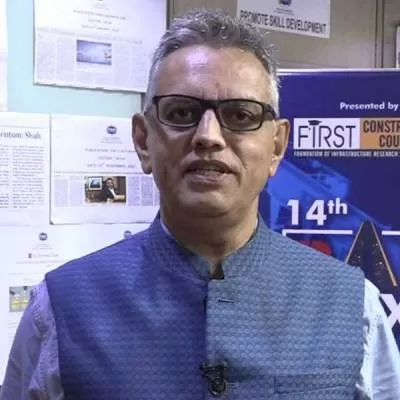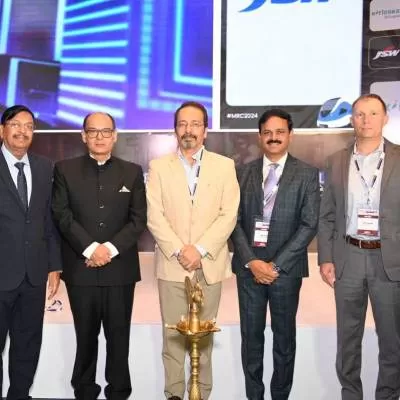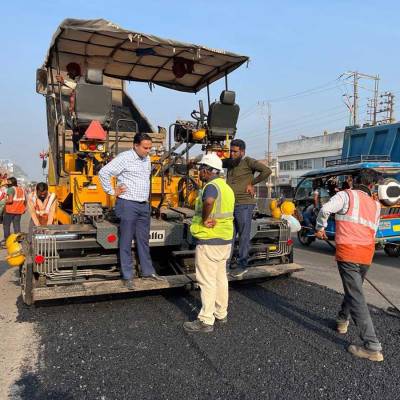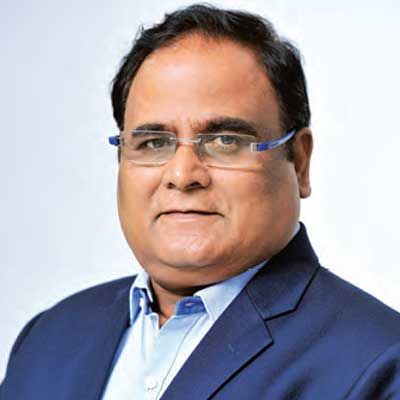- Home
- Real Estate
- High on green
High on green
Meeting the growing demands for aerated autoclaved concrete (ACC) blocks in Delhi, Gujarat, Madhya Pradesh, Maharashtra and Rajasthan is Hyderabad Industries Ltd (HIL). What's more, with its green product, the company's ACC blocks manufacturing plant in Golan recently received the CII-GreenCo Gold rating and gained an eligibility for about 35,000-40,000 carbon emission reductions per annum by UNFCCC. Consider this, one carbon credit is equivalent to 1 tonne of carbon dioxide. Abhaya Shankar, Managing Director, HIL, highlights the requirements under the GreenCo Gold rating along with the plant's green initiatives in conversation with SHRIYAL SETHUMADHAVAN.
Top 10 parameters
The CII GreenCo rating is a far more comprehensive green manufacturing unit rating system, under which you are judged on 10 parameters: energy efficiency, water conservation, renewable energy, greenhouse gas reduction, waste management, material conservation and recycling, green supply chain, product stewardship and lifecycle assessments along with other parameters like ventilation, site selection, surrounding society impact, etc.
As compared to rating systems like GRIHA and IGBC LEED, these systems independently introduced their rating systems for commercial and residential buildings followed by a system for rating products as green. Then there was an internal thinking in the IGBC, where a decision was made to introduce a specific green rating system for manufacturing units and factories, which did not exist in India then.
Golan plant: A snapshot
Located near Surat in a small town called Golan, and spread across 25 acre, the plant's location is such that it can primarily serve both Gujarat and Maharashtra, among other states, in a big way. These are fast growing markets with a lot of construction activities happening. That was one reason that compelled us to choose this particular location. This was in addition to factors such as easy availability of power, manpower and water etc.
The green way
Since day one of setting up this plant, we have worked around two concepts - green and lean. Although our plant has been operational since 2009, in fact in full swing since 2010, we did not have a rating system for manufacturing plants to apply. Hence, when the CII GreenCo Gold rating system was launched, we applied for the same and since then, there have been continuous add-ons in terms of go green. Also, from the design point of view, while a consultant advised us on the lean management, the architect considered the same while designing the structure. Like PPM and PQM, we also introduced WCM - that is World Class Manufacturing system. The system is about manufacturing excellence, be it in maintenance, housekeeping, quality, proper standard operating procedures, visual management, training, etc. This manufacturing system talks about people ensuring that the plant is operating very efficiently. It also helps us be extremely environment conscious, using minimal energy with as little waste or pollution as possible.
Energy at its best
We aimed at using all electrical equipment like pumps, motors and variable frequency drives, etc, to ensure that they are energy efficient and utilised properly. Then we have a dedicated energy management team with clearly defined roles and responsibilities to keep a check on these issues. Part of this is an energy scorecard as well, introduced for individual employees. Further, we have installed a wind mill for renewable energy and are now going to shift to a briquette-fired boiler. This boiler, instead of burning highly polluting coal or fuel furnace oil, which has very high carbon emissions, will be more of an eco-friendly agriculture waste-based fired boiler. We have also set a target for 100 per cent dependency on renewable energy by 2013. Having already achieved close to 40 per cent of this, by doing away with fossil fuels, we would be 100 per cent dependent on renewable energy. Hopefully this should be achieved by the year end. In the case of renewable energy, we generate and supply to the grid, through which we get power for our plant. So, the global benchmark for a plant of this size is approximately 16 kWh per cu m for a product. The product manufactured is measured in cubic metres. And with the windmills, what our plant at Golan is achieving is 11.2 kWh per cu m.
The rating pays complete attention to energy saving and the use of energy efficient equipment. So these are the disciplines that you have to inculcate within the plant, and that is precisely what the whole rating system is about. In this direction, we have a unique concept that we define as the 'five way' green. So number one is the use of raw materials with low carbon footprint and waste materials like flyash. Number two is to have a green manufacturing process that is energy efficient, non-effluent, non-pollutant, no gap emission, no waste pollution, waste generation and pollution. All of this can be classified under the green manufacturing process. Thirdly, we use renewable energy or clean energy like briquettes and windmills. Four is that we do not have any waste generating products and byproducts, which in itself is a clutch for the pollution control department to deal with. Even if waste is generated, we convert it into a product. Lastly, the final product is green. For instance, ACC blocks, when used, can actually cut down the air-conditioning cost by 25 per cent. It also reduces steel consumption - which has a very high carbon footprint - due to its light weight. So if through our products we can help a building save 1,000 tonne of steel, I will believe that we are contributing to the environment in a big way.
Zero water discharge
ACC blocks is produced in zero water discharge. We require some water in our process. Once the products are manufactured, there may be some products where there is a lot of discharge, which from the factory go straight into the soil, polluting the same. However, in the case of ACC blocks, whatever water we use during the process, is reused. That means that we are not discharging any water outside the plants - hence zero water discharge. Apart from this, we have installed a rainwater harvesting plant. All the water is collected and reused in some areas of the plant and our landscape areas. We do drip irrigation as well and follow all sorts of good practices to avoid wastage of water in the plant.
Materials play
The plant manufactures ACC blocks, which is eco-friendly. As per this rating, about 75 points are allotted to products and services used in building the plant; we scored 50 points here. Various energy saving devices have been incorporated in our plant and we have used ACC blocks as these are lightweight, resistant to fire and earthquake and are major contributors to achieving the scores. Aerocon blocks were used in the administration building. These blocks can easily replace red bricks. We have also used aerocon panels that are used for internal partitioning. In terms of local materials, we have used whatever was easily available. Flyash was one such material, which we sourced from within 60-70 km.
Waste management
Golan has achieved zero liquid discharge facility and 100 per cent of the product content is recycled. As the liquid discharge here is basically water, we have installed an RO plant through which the waste water is purified and reused. Further, our product is 100 per cent recyclable and we have achieved almost 24 per cent reduction in packing materials from what we started off. Then we have maximised the use of flyash by 65 per cent. And instead of plastic bags, we use bulkers.
Green supply chain
Our supply chain supports green practices, which takes you closer to achieving this Gold rating. So firstly, our raw materials are green and the way we transport it to the plant, which is also part of the supply chain is green. Hence, bringing materials in bulkers helps us avoid wasteful practices that are involved in material packaging. Also, we have a vendor selection process through which we find out how green that vendor is; in this case we get a higher vendor rating and obviously improve their chances of being a supplier to us.
Product stewardship
We are a company that not only produces products but also offers solutions to various stakeholders, our customers and influencers. So the way we ensure product stewardship is that we keep educating the architects and structural consultants about designing buildings by using lightweight materials and therefore save steel and cut down on costs and labour.
Money matters
The money being expended in this plant will be close to Rs 100 crore with additional investments. In a scenario where we don't compromise on energy, sustainability, green the payback will be within four years. So, building a green project will initially incur additional investments, but ultimately it pays for itself. So, no company should hesitate going this way.
Project details
Size of the project: 22 acre (plot area); and 2.5 acre (built up area)
Cost: Rs 572 per MT (fixed); Rs 1,629 per MT (variable)
Completion: 2009
Contractor: KKB projects, Surat. Tel: 0261-249 1690.
Architects/Planners: Modi Associates, Surat.
Green Consultant: Sabhyachi, Muthusezhiyan - CII.
Structural, services, electrical and plumbing consultants: Modi Associates, Surat.
External cladding consultants: Modi Associates, Surat.
External cladding and painting contractor: KKB projects, Surat.
Abhaya Shankar's Perspective
"India being a developing country, our requirements for development is high. One reason is that we already fall in a slot of developing and emerging economies. We are not a stable economy like the US whose energy consumption or carbon footprints may have sort of flattened. India has a huge population - one sixth of the world population is Indian - so obviously there will be an increase in the need for infrastructure, residences, commercial space, schools and colleges, bridges, flyovers, more electricity and water. Amidst, all of this, we need to go the green way."
Would you like to share details of any green initiatives? Write in at feedback@ASAPPmedia.com
HIL's ACC Blocks Golan plant becomes the first in the building materials sector in India to receive CII's GreenCo Gold rating. Meeting the growing demands for aerated autoclaved concrete (ACC) blocks in Delhi, Gujarat, Madhya Pradesh, Maharashtra and Rajasthan is Hyderabad Industries Ltd (HIL). What's more, with its green product, the company's ACC blocks manufacturing plant in Golan recently received the CII-GreenCo Gold rating and gained an eligibility for about 35,000-40,000 carbon emission reductions per annum by UNFCCC. Consider this, one carbon credit is equivalent to 1 tonne of carbon dioxide. Abhaya Shankar, Managing Director, HIL, highlights the requirements under the GreenCo Gold rating along with the plant's green initiatives in conversation with SHRIYAL SETHUMADHAVAN. Top 10 parameters The CII GreenCo rating is a far more comprehensive green manufacturing unit rating system, under which you are judged on 10 parameters: energy efficiency, water conservation, renewable energy, greenhouse gas reduction, waste management, material conservation and recycling, green supply chain, product stewardship and lifecycle assessments along with other parameters like ventilation, site selection, surrounding society impact, etc. As compared to rating systems like GRIHA and IGBC LEED, these systems independently introduced their rating systems for commercial and residential buildings followed by a system for rating products as green. Then there was an internal thinking in the IGBC, where a decision was made to introduce a specific green rating system for manufacturing units and factories, which did not exist in India then. Golan plant: A snapshot Located near Surat in a small town called Golan, and spread across 25 acre, the plant's location is such that it can primarily serve both Gujarat and Maharashtra, among other states, in a big way. These are fast growing markets with a lot of construction activities happening. That was one reason that compelled us to choose this particular location. This was in addition to factors such as easy availability of power, manpower and water etc. The green way Since day one of setting up this plant, we have worked around two concepts - green and lean. Although our plant has been operational since 2009, in fact in full swing since 2010, we did not have a rating system for manufacturing plants to apply. Hence, when the CII GreenCo Gold rating system was launched, we applied for the same and since then, there have been continuous add-ons in terms of go green. Also, from the design point of view, while a consultant advised us on the lean management, the architect considered the same while designing the structure. Like PPM and PQM, we also introduced WCM - that is World Class Manufacturing system. The system is about manufacturing excellence, be it in maintenance, housekeeping, quality, proper standard operating procedures, visual management, training, etc. This manufacturing system talks about people ensuring that the plant is operating very efficiently. It also helps us be extremely environment conscious, using minimal energy with as little waste or pollution as possible. Energy at its best We aimed at using all electrical equipment like pumps, motors and variable frequency drives, etc, to ensure that they are energy efficient and utilised properly. Then we have a dedicated energy management team with clearly defined roles and responsibilities to keep a check on these issues. Part of this is an energy scorecard as well, introduced for individual employees. Further, we have installed a wind mill for renewable energy and are now going to shift to a briquette-fired boiler. This boiler, instead of burning highly polluting coal or fuel furnace oil, which has very high carbon emissions, will be more of an eco-friendly agriculture waste-based fired boiler. We have also set a target for 100 per cent dependency on renewable energy by 2013. Having already achieved close to 40 per cent of this, by doing away with fossil fuels, we would be 100 per cent dependent on renewable energy. Hopefully this should be achieved by the year end. In the case of renewable energy, we generate and supply to the grid, through which we get power for our plant. So, the global benchmark for a plant of this size is approximately 16 kWh per cu m for a product. The product manufactured is measured in cubic metres. And with the windmills, what our plant at Golan is achieving is 11.2 kWh per cu m. The rating pays complete attention to energy saving and the use of energy efficient equipment. So these are the disciplines that you have to inculcate within the plant, and that is precisely what the whole rating system is about. In this direction, we have a unique concept that we define as the 'five way' green. So number one is the use of raw materials with low carbon footprint and waste materials like flyash. Number two is to have a green manufacturing process that is energy efficient, non-effluent, non-pollutant, no gap emission, no waste pollution, waste generation and pollution. All of this can be classified under the green manufacturing process. Thirdly, we use renewable energy or clean energy like briquettes and windmills. Four is that we do not have any waste generating products and byproducts, which in itself is a clutch for the pollution control department to deal with. Even if waste is generated, we convert it into a product. Lastly, the final product is green. For instance, ACC blocks, when used, can actually cut down the air-conditioning cost by 25 per cent. It also reduces steel consumption - which has a very high carbon footprint - due to its light weight. So if through our products we can help a building save 1,000 tonne of steel, I will believe that we are contributing to the environment in a big way. Zero water discharge ACC blocks is produced in zero water discharge. We require some water in our process. Once the products are manufactured, there may be some products where there is a lot of discharge, which from the factory go straight into the soil, polluting the same. However, in the case of ACC blocks, whatever water we use during the process, is reused. That means that we are not discharging any water outside the plants - hence zero water discharge. Apart from this, we have installed a rainwater harvesting plant. All the water is collected and reused in some areas of the plant and our landscape areas. We do drip irrigation as well and follow all sorts of good practices to avoid wastage of water in the plant. Materials play The plant manufactures ACC blocks, which is eco-friendly. As per this rating, about 75 points are allotted to products and services used in building the plant; we scored 50 points here. Various energy saving devices have been incorporated in our plant and we have used ACC blocks as these are lightweight, resistant to fire and earthquake and are major contributors to achieving the scores. Aerocon blocks were used in the administration building. These blocks can easily replace red bricks. We have also used aerocon panels that are used for internal partitioning. In terms of local materials, we have used whatever was easily available. Flyash was one such material, which we sourced from within 60-70 km. Waste management Golan has achieved zero liquid discharge facility and 100 per cent of the product content is recycled. As the liquid discharge here is basically water, we have installed an RO plant through which the waste water is purified and reused. Further, our product is 100 per cent recyclable and we have achieved almost 24 per cent reduction in packing materials from what we started off. Then we have maximised the use of flyash by 65 per cent. And instead of plastic bags, we use bulkers. Green supply chain Our supply chain supports green practices, which takes you closer to achieving this Gold rating. So firstly, our raw materials are green and the way we transport it to the plant, which is also part of the supply chain is green. Hence, bringing materials in bulkers helps us avoid wasteful practices that are involved in material packaging. Also, we have a vendor selection process through which we find out how green that vendor is; in this case we get a higher vendor rating and obviously improve their chances of being a supplier to us. Product stewardship We are a company that not only produces products but also offers solutions to various stakeholders, our customers and influencers. So the way we ensure product stewardship is that we keep educating the architects and structural consultants about designing buildings by using lightweight materials and therefore save steel and cut down on costs and labour. Money matters The money being expended in this plant will be close to Rs 100 crore with additional investments. In a scenario where we don't compromise on energy, sustainability, green the payback will be within four years. So, building a green project will initially incur additional investments, but ultimately it pays for itself. So, no company should hesitate going this way. Project details Size of the project: 22 acre (plot area); and 2.5 acre (built up area) Cost: Rs 572 per MT (fixed); Rs 1,629 per MT (variable) Completion: 2009 Contractor: KKB projects, Surat. Tel: 0261-249 1690. Architects/Planners: Modi Associates, Surat. Green Consultant: Sabhyachi, Muthusezhiyan - CII. Structural, services, electrical and plumbing consultants: Modi Associates, Surat. External cladding consultants: Modi Associates, Surat. External cladding and painting contractor: KKB projects, Surat. Abhaya Shankar's Perspective India being a developing country, our requirements for development is high. One reason is that we already fall in a slot of developing and emerging economies. We are not a stable economy like the US whose energy consumption or carbon footprints may have sort of flattened. India has a huge population - one sixth of the world population is Indian - so obviously there will be an increase in the need for infrastructure, residences, commercial space, schools and colleges, bridges, flyovers, more electricity and water. Amidst, all of this, we need to go the green way. Would you like to share details of any green initiatives? Write in at feedback@ASAPPmedia.com
























